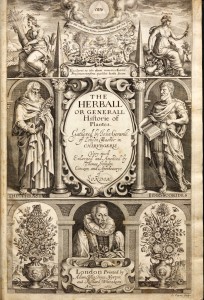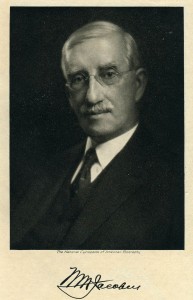An Elizabethan Herbal
I’d like to notice two editions of John Gerard’s (1545-1612) famous herbal in the Watkinson:
 The Herball; or, Generall Historie of Plantes (London, 1597), and The Herball, or General Historie of Plantes . . . very much enlarged and amended (London, 1636).
The Herball; or, Generall Historie of Plantes (London, 1597), and The Herball, or General Historie of Plantes . . . very much enlarged and amended (London, 1636).
[The following description is quoted directly from the antiquarian firm Philadelphia Rare Books & Manuscripts, which was describing another copy for sale]
The story is famous: John Norton, Queen’s printer, wished to bring out an English language version of Dodoen’s Pemptades of 1583 and hired a certain “Dr. Priest” to do so, but the translator died with the work only partially done. A copy of the manuscript translation made its way into John Gerard’s hands and he seized the opportunity, reorganizing the contents, obscuring the previous translator’s contribution, incorporating aspects of Rembert and Cruydenboeck’s works, and commandeering the result as his own.
Gerard abandoned Dodoen’s classification, opting for l’Obel’s instead, and, in a stroke of ambition and brilliance, illustrated the work with more than 2,500 woodcuts of plants. Many of these are large and all are attractive but more than a few were of plants he himself did not know, thus leading to considerable confusion between illustration and text in the earliest editions, this being third overall and the second with Thomas Johnson’s additions and amendments.
 For both Johnson editions a large number of the woodcuts were obtained from the famous Leyden printing and publishing firm of Moretus, successors to the highly famous firm of Plantin. As Johnston notes: “Most of the cuts were those used in the botanicals published by Plantin, although a number of new woodcuts were added after drawings by Johnson and Goodyer” (Cleveland Herbal . . . Collections, #185). The large thick volume begins with a handsome engraved title-page by John Payne incorporating a bust of the author, urns with flowers and herbs, and full-length seated images of Dioscorides and Theophrastus and of Ceres and Pomona. Replacing the missing initial blank is a later leaf on which is mounted a large engraving of Gerard. The text is printed in italic, roman, and gothic type.
For both Johnson editions a large number of the woodcuts were obtained from the famous Leyden printing and publishing firm of Moretus, successors to the highly famous firm of Plantin. As Johnston notes: “Most of the cuts were those used in the botanicals published by Plantin, although a number of new woodcuts were added after drawings by Johnson and Goodyer” (Cleveland Herbal . . . Collections, #185). The large thick volume begins with a handsome engraved title-page by John Payne incorporating a bust of the author, urns with flowers and herbs, and full-length seated images of Dioscorides and Theophrastus and of Ceres and Pomona. Replacing the missing initial blank is a later leaf on which is mounted a large engraving of Gerard. The text is printed in italic, roman, and gothic type.
There is, to us, a surprising and very interesting section on grapes and wines. The first part of our caption delights partly in discovery that maize, the “corn” of the U.S., is here called “turkey wheat” — with further note that you can make bread of it, but that the result is pleasing only to “barbarous” tastes! The entry as a whole shows Gerard at his characteristic best, at once scientifically systematic and engagingly discursive.


